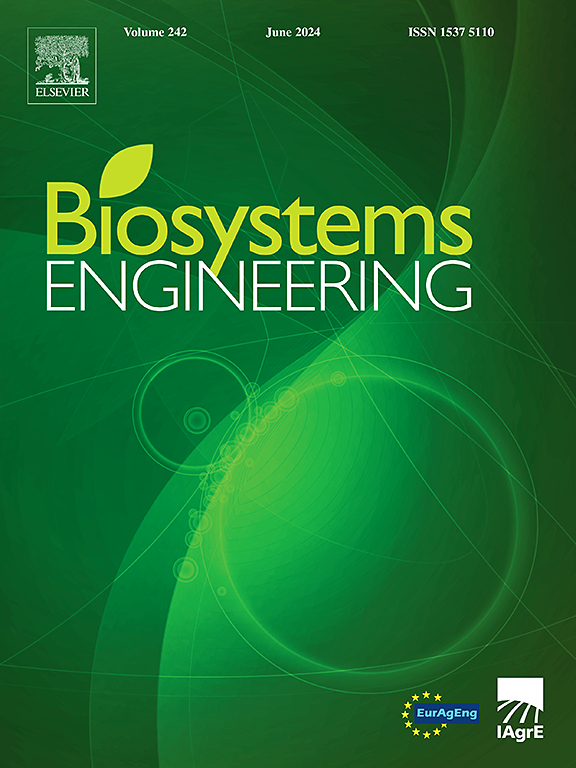3D time-series phenotyping of lettuce in greenhouses
IF 4.4
1区 农林科学
Q1 AGRICULTURAL ENGINEERING
引用次数: 0
Abstract
Monitoring the growth dynamics of plants in three-dimensional (3D) space is one of the most fundamental data acquisition requirements for plant breeding and cultivation. The rapid development of high-throughput plant phenotyping platforms (HTPPP) makes it possible to obtain big data in plant phenomics. However, how to extract phenotypes from the raw phenotyping data to obtain the agronomic indicators demanded by agronomists has become an urgent issue. In this study, time-series point clouds of potted lettuce plants were generated via multi-view stereo (MVS) method using top-view Red, Green, Blue (RGB) images acquired by a rail-driven HTPPP in a greenhouse. A time-series point cloud registration method was proposed by extracting pots as features, and daily population-individual plant point cloud segmentation was achieved based on the registration information and contrasted with two other different segmentation methods. Then vegetation and pot was segmented using the random forest (RF). Finally, the phenotypes including plant height, crown width, and convex hull volume of each plant were extracted. The results show that the average mean intersection over union (mIoU), mean precision (mPr), mean recall (mRe), and mean F1-score (mF1) of the population-individual plant segmentation were 71.86%, 97.38%, 86.08%, and 91.02%, respectively. The vegetation-pot point cloud segmentation achieved an accuracy of 98.81%. The averaged coefficient of determination (R2) for the extracted plant height and crown width were 0.79 and 0.60, respectively, with the averaged root mean square error (RMSE) being 0.05 m and 0.03 m, respectively. The accuracy of plant height was significantly higher than that of PlantEye. The extracted phenotypes can be used to quantitatively differentiate the growth dynamics of different sub-populations of lettuce plants. This study presents an automated solution for extracting time-series 3D phenotypes under HTPPP in a greenhouse. It provides crucial technological support for efficient phenotype acquisition in plant breeding and cultivation.
温室生菜三维时间序列表型分析
在三维空间中监测植物的生长动态是植物育种和栽培最基本的数据采集要求之一。高通量植物表型平台(HTPPP)的快速发展使植物表型组学大数据的获取成为可能。然而,如何从原始表型数据中提取表型以获得农学家所需的农艺指标已成为一个迫切需要解决的问题。本研究利用温室内轨道驱动HTPPP获取的顶视图红、绿、蓝(RGB)图像,通过多视角立体(MVS)方法生成盆栽生菜的时间序列点云。提出了一种以盆为特征的时间序列点云配准方法,基于配准信息实现了植物日种群-个体点云的分割,并与其他两种不同的点云分割方法进行了对比。然后利用随机森林(RF)对植被和盆栽进行分割。最后提取各植株的株高、冠宽、凸壳体积等表型。结果表明,种群-单株分割的平均交联度(mIoU)、平均精密度(mPr)、平均召回率(mRe)和平均f1得分(mF1)分别为71.86%、97.38%、86.08%和91.02%。植被盆点云分割准确率达到98.81%。提取的株高和冠宽的平均决定系数(R2)分别为0.79和0.60,平均均方根误差(RMSE)分别为0.05 m和0.03 m。植株高度的精度显著高于PlantEye。提取的表型可用于定量区分生菜不同亚群的生长动态。本研究提出了一种在温室HTPPP条件下提取时间序列3D表型的自动化解决方案。它为植物育种和栽培中高效的表型获取提供了重要的技术支持。
本文章由计算机程序翻译,如有差异,请以英文原文为准。
求助全文
约1分钟内获得全文
求助全文
来源期刊

Biosystems Engineering
农林科学-农业工程
CiteScore
10.60
自引率
7.80%
发文量
239
审稿时长
53 days
期刊介绍:
Biosystems Engineering publishes research in engineering and the physical sciences that represent advances in understanding or modelling of the performance of biological systems for sustainable developments in land use and the environment, agriculture and amenity, bioproduction processes and the food chain. The subject matter of the journal reflects the wide range and interdisciplinary nature of research in engineering for biological systems.
 求助内容:
求助内容: 应助结果提醒方式:
应助结果提醒方式:


